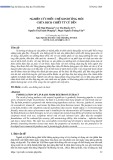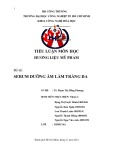
Academic Editors: Thomas J. Schmidt
and Enrique Barrajón-Catalán
Received: 3 December 2024
Revised: 3 January 2025
Accepted: 29 January 2025
Published: 31 January 2025
Citation: Kirkova, D.; Stremski, Y.;
Bachvarova, M.; Todorova, M.;
Goranov, B.; Statkova-Abeghe, S.;
Docheva, M. New
Benzothiazole–Monoterpenoid
Hybrids as Multifunctional Molecules
with Potential Applications in
Cosmetics. Molecules 2025,30, 636.
https://doi.org/10.3390/
molecules30030636
Copyright: © 2025 by the authors.
Licensee MDPI, Basel, Switzerland.
This article is an open access article
distributed under the terms and
conditions of the Creative Commons
Attribution (CC BY) license
(https://creativecommons.org/
licenses/by/4.0/).
Article
New Benzothiazole–Monoterpenoid Hybrids as Multifunctional
Molecules with Potential Applications in Cosmetics
Desislava Kirkova 1, Yordan Stremski 2,* , Maria Bachvarova 2, Mina Todorova 2, Bogdan Goranov 3,
Stela Statkova-Abeghe 2and Margarita Docheva 1
1Agricultural Academy, Tobacco and Tobacco Products Institute, 4108 Markovo, Bulgaria;
desislavaa894@gmail.com (D.K.); margarita_1980@abv.bg (M.D.)
2Department of Organic Chemistry, University of Plovdiv “Paisii Hilendarski”, 24 Tsar Asen Str.,
4000 Plovdiv, Bulgaria; bychvarova@uni-plovdiv.bg (M.B.); minatodorova@uni-plovdiv.bg (M.T.);
stab@uni-plovdiv.bg (S.S.-A.)
3Department of Microbiology and Biotechnology, University of Food Technologies, 26 Maritza Boulevard,
4002 Plovdiv, Bulgaria; b_goranov@uft-plovdiv.bg
*Correspondence: stremski@uni-plovdiv.net; Tel.: +359-32-261-346
Abstract: The Thymus vulgaris and Origanum vulgare essential oils (contained thymol and
carvacrol in a range of 35–80%) are used in various products in the fields of medicine,
cosmetics, and foods. Molecular hybridization between benzothiazole (BT) and phe-
nolic monoterpenoids is a promising method for the development of biologically ac-
tive compounds. New benzothiazole–monoterpenoid hybrids were synthesized through
a regioselective
α
-amidoalkylation reaction of thymol and carvacrol with high yields
(70–96%). This approach is both simple and cost-effective, employing easily accessi-
ble and inexpensive reagents to produce target molecules. The structure of the synthe-
sized compounds was characterized spectrally using
1
H-,
13
C-NMR, FT-IR, and HRMS
data. The newly obtained compounds are structural analogues of the UVB filter PBSA,
which is used in cosmetics. The spectral properties of the aromatic products thymol
hybrid (2-(4-hydroxy-5-isopropyl-2-methylphenyl)benzo[d]thiazole) and carvacrol hy-
brid (2-(4-hydroxy-2-isopropyl-5-methylphenyl)benzo[d]thiazole) were successfully ex-
amined, using a validated spectrophotometric method. SPF values varied from 31 to
36, compared to the PBSA (30), and were observed at concentrations of 1–0.25 mM.
2-Hydroxyphenylbenzothiazoles
are known antimicrobial and antioxidant agents that have
potential applications in the food industry and cosmetics as preservatives and antioxidants.
In this context, antimicrobial activity of the hybrid compounds was evaluated using the
agar diffusion method against E. coli,S. aureus,P. aeruginosa, and C. albicans. Compounds of
methyl-2-(4-hydroxy-2-isopropyl-5-methylphenyl)benzo[d]thiazole-3(2H)-carboxylate con-
taining carvacrol fragments showed high activity against Staphylococcus aureus ATCC 25923
(with 0.044
µ
mol content). The radical scavenging activity was determined using ABTS and
DPPH assays, the highest activity was exhibited by the thymol hybrids ethyl-2-(4-hydroxy-
5-isopropyl-2-methylphenyl)benzo[d]thiazole-3(2H)-carboxylate (IC
50
—133.70
±
10
µ
M)
and methyl-2-(4-hydroxy-5-isopropyl-2-methylphenyl)benzo[d]thiazole-3(2H)-carboxylate
(IC
50
—157.50
±
10
µ
M), defined by ABTS. The aromatic benzothiazole–monoterpenoid
hybrids are classified using in silico analyses as non-mutagenic, with low toxicity, and they
are non-irritating to the skin. These compounds were identified as new hit scaffolds for
multifunctional molecules in cosmetics.
Keywords:
α
-amidoalkylation; molecular hybridization; thymol; carvacrol; in silico
predictions; sun-protection factor; PBSA; antimicrobial activity
Molecules 2025,30, 636 https://doi.org/10.3390/molecules30030636

Molecules 2025,30, 636 2 of 25
1. Introduction
The synthesis of multifunctional hybrid molecules is a relatively new strategy, initially
employed to overcome the increasing rate of drug resistance to anticancer or antitubercular
agents [
1
,
2
]. This strategy involves the combination of various heterocycles, which could
enhance the anticancer activity of the hybrid molecules compared to that of the starting
compounds [
3
]. Additionally, molecular hybridization can be used to obtain new mul-
tifunctional molecules with potential applications in cosmetics. In recent years, various
authors have reported new biologically active compounds, structural analogues of natu-
ral substances. For instance, Valverde Sancho et al. proposed a convenient method for
obtaining hybrid molecules with proven high biological activity based on essential oils [
4
].
The interest in the application of essential oils (EOs) in organic synthesis is due to their
perception as safe at certain concentrations, owing to their high volatility and biodegradabil-
ity, as well as their incorporation into pharmaceuticals and agricultural products. Thyme
EO is one of the widely used oils in various products in the fields of medicine. Additionally,
it is used in the food industry and cosmetics as a preservative and antioxidant [
5
,
6
]. In
traditional medicine, wild thyme (Thymus serpyllum L.) is included in a large number of
herbal medicinal products, such as syrups, tinctures, teas, and decoctions [
5
]. Thyme EO
is preferred for use in pharmaceuticals due to its high thymol content, which has strong
antitussive, spasmolytic, and expectorant effects. Its antiseptic action is estimated to be
25 times more effective than phenol (PhOH), but with lower toxicity [7].
There are numerous types and varieties of thyme (Thymus vulgaris). The genus Thy-
mus is one of the most important of the Lamiaceae family, represented by 214 species and
36 subspecies
. In Europe, six genetically distinct chemotypes of thyme predominantly exist:
two phenolic (thymol, carvacrol) and four non-phenolic (linalool, geraniol,
α
-terpineol, and
trans-4-thujanol/4-terpinenol) [
8
]. The content of the monoterpenoids thymol and carvacrol
in some essential oils reaches up to about 80% [
9
]. Thymol (2-isopropyl-5-methylphenol)
and carvacrol (5-isopropyl-2-methylphenol) are the most important volatile organic com-
pounds in thyme essential oil [
7
]. They are relatively unstable to oxidation, distillation,
heating, or exposure to light [
9
,
10
]. Thymol and carvacrol are natural phenolic isomers
with a wide range of pharmaceutical activities, including antibacterial, antimicrobial, an-
tioxidant, cytotoxic, and insecticidal properties [
10
,
11
]. The literature represents plenty
of data, including comparisons between the activities of thymol and carvacrol. Aazza
and colleagues found that the antioxidant activity of the two isomers is approximately
equal, while the anti-acetylcholinesterase activity depends on the position of the hydroxyl
group relative to the two alkyl substituents [
12
]. Miladi et al. investigated the
in vitro
antibacterial activity of thymol and carvacrol against Gram-positive and Gram-negative
bacteria. The results showed that thymol and carvacrol possess high activity against the
tested strains [13].
The anticancer activity of carvacrol has been evaluated
in vitro
. It was found that
carvacrol significantly reduces the viability of gastric adenocarcinoma (AGS) cells at concen-
trations ranging from 10 to 600
µ
mol/L [
14
]. In 2020, Mari and colleagues investigated cell
cycle arrest and apoptosis in breast cancer cells using carvacrol [
15
]. A comparison of the
anticancer effects of thymol and carvacrol was made by Elbe and colleagues. It was found
that thymol is more effective than carvacrol in preventing the growth of ovarian cancer cells
in a dose- and time-dependent manner, although the exact mechanism is still unclear [16].
The application of thymol and carvacrol in skincare products is due to its ability to
protect cells from damage caused by oxidative stress, and it is also effective as an inhibitor
of the enzymes elastase and tyrosinase [
17
–
19
]. Tyrosinase inhibitors are important in
medicine and cosmetics due to their ability to suppress the overproduction of melanin and
prevent unwanted effects on the skin [
10
]. Improper or excessive exposure to ultraviolet

Molecules 2025,30, 636 3 of 25
rays can lead to oxidative stress caused by excessive accumulation of reactive oxygen
species (ROS) that are not balanced by effective antioxidant protection. Additionally, this
is the main cause of both melanoma and non-melanoma skin cancer. Ultraviolet rays
are classified as one of the main causes of skin cancer [
20
,
21
]. Many plant polyphenols,
including flavonoids, are reported to have significant photoprotective effects on the skin
(antioxidant, anti-inflammatory, and anticancer potential), and some also act as mild UV
filters. The existence of hydroxyl groups and aromatic structures facilitates the absorption
of UV radiation across a broad spectrum of wavelengths that underpins their character-
istics [
22
]. Recent studies indicate that polyphenols can provide an effective source for
protecting the skin from the harmful effects of UV rays (UVA and UVB) [
23
]. 2-Phenyl-
1H-benzimidazole-5-sulfonic acid (PBSA) is widely used in cosmetic sunscreens due to its
ability to absorb UVB rays and its high water solubility [
24
]. A recent work describes the
application of PBSA in various cosmetic products and a series of its 2-heteroaryl-benzoazole
analogues as privileged structures for new multifunctional molecules [25].
In 2020, our synthetic group successfully applied a multicomponent reaction for the
amidoalkylation of hydroxyarenes toward the formation of 2-(hydroxyaryl)benzothiazolines
and an aromatic product, 4-(benzo[d]thiazol-2-yl)phenol (BT-PhOH hybrid, Figure 1), with
antibacterial properties [
26
]. The antibacterial activity of these molecules was investi-
gated against two Gram-positive strains (Staphylococcus aureus ATCC 6538 P and Bacillus
licheniformis ATCC 14580) and one Gram-negative strain (Escherichia coli ATCC 8739). The
BT-PhOH hybrid was found to exhibit high antibacterial activity against S. aureus ATCC
6538P, with a MIC of 0.0063 mg/mL [26].
Molecules 2025, 30, x FOR PEER REVIEW 3 of 25
classified as one of the main causes of skin cancer [20,21]. Many plant polyphenols, in-
cluding flavonoids, are reported to have significant photoprotective effects on the skin
(antioxidant, anti-inflammatory, and anticancer potential), and some also act as mild UV
filters. The existence of hydroxyl groups and aromatic structures facilitates the absorption
of UV radiation across a broad spectrum of wavelengths that underpins their characteris-
tics [22]. Recent studies indicate that polyphenols can provide an effective source for pro-
tecting the skin from the harmful effects of UV rays (UVA and UVB) [23]. 2-Phenyl-1H-
benzimidazole-5-sulfonic acid (PBSA) is widely used in cosmetic sunscreens due to its
ability to absorb UVB rays and its high water solubility [24]. A recent work describes the
application of PBSA in various cosmetic products and a series of its 2-heteroaryl-benzo-
azole analogues as privileged structures for new multifunctional molecules [25].
In 2020, our synthetic group successfully applied a multicomponent reaction for the
amidoalkylation of hydroxyarenes toward the formation of 2-(hydroxyaryl)benzothia-
zolines and an aromatic product, 4-(benzo[d]thiazol-2-yl)phenol (BT-PhOH hybrid, Fig-
ure 1), with antibacterial properties [26]. The antibacterial activity of these molecules was
investigated against two Gram-positive strains (Staphylococcus aureus ATCC 6538 P and
Bacillus licheniformis ATCC 14580) and one Gram-negative strain (Escherichia coli ATCC
8739). The BT-PhOH hybrid was found to exhibit high antibacterial activity against S. au-
reus ATCC 6538P, with a MIC of 0.0063 mg/mL [26].
Djuidje and collaborators also introduced strategies for the synthesis of the afore-
mentioned compound 4-(benzo[d]thiazol-2-yl)phenol and various other analogues (Fig-
ure 1) via condensation reaction between 2-aminothiophenols and different benzalde-
hydes. The synthesized compounds were evaluated for their multifunctional effectiveness
as antioxidant, sunscreen filter, antifungal, and antiproliferative agents [27]. 2-Phe-
nylbenzo[d]thiazole was chosen by Djuidje as a reference standard for appropriate dis-
cussing of structure–activity relationship, as the structures of 2-(benzo[d]thiazol-2-yl)ben-
zene-1,4-diol and 5-(benzo[d]thiazol-2-yl)benzene-1,2,4-triol (Figure 1) were identified by
the authors as molecules with high radical scavenging activity and potential for designing
multifunctional drugs. C-2-substituted arylbenzoazoles can be highly effective as β-amy-
loid-targeting imaging agents; calcium channel antagonists; chemiluminescent, antituber-
cular, antiparasitic, and antitumor agents; and also photosensitizers [28–31]. The discov-
ery of sunscreen products with combined additional antimicrobial and antioxidant prop-
erties is of great interest.
Figure 1. The structures of some multifunctional molecules containing BT and hydroxyl-aryl frag-
ments.
From some synthetic perspectives, the production of benzothiazole–monoterpenoid
hybrid molecules with a carbon–carbon-linked benzoazole fragment, using readily avail-
able renewable sources, such as essential oils, is of great interest. The literature contains
successful data on O-alkylation, O-acylation [31,32], and C-acylation [10] for synthesizing
thymol and carvacrol derivatives. However, the data show that this is not easily applica-
Figure 1. The structures of some multifunctional molecules containing BT and hydroxyl-aryl
fragments.
Djuidje and collaborators also introduced strategies for the synthesis of the aforemen-
tioned compound 4-(benzo[d]thiazol-2-yl)phenol and various other analogues (Figure 1) via
condensation reaction between 2-aminothiophenols and different benzaldehydes. The syn-
thesized compounds were evaluated for their multifunctional effectiveness as antioxidant,
sunscreen filter, antifungal, and antiproliferative agents [
27
]. 2-Phenylbenzo[d]thiazole
was chosen by Djuidje as a reference standard for appropriate discussing of structure–
activity relationship, as the structures of 2-(benzo[d]thiazol-2-yl)benzene-1,4-diol and
5-(benzo[d]thiazol-2-yl)benzene-1,2,4-triol (Figure 1) were identified by the authors as
molecules with high radical scavenging activity and potential for designing multifunctional
drugs. C-2-substituted arylbenzoazoles can be highly effective as
β
-amyloid-targeting imag-
ing agents; calcium channel antagonists; chemiluminescent, antitubercular, antiparasitic,
and antitumor agents; and also photosensitizers [
28
–
31
]. The discovery of sunscreen prod-
ucts with combined additional antimicrobial and antioxidant properties is of
great interest
.
From some synthetic perspectives, the production of benzothiazole–monoterpenoid
hybrid molecules with a carbon–carbon-linked benzoazole fragment, using readily avail-

Molecules 2025,30, 636 4 of 25
able renewable sources, such as essential oils, is of great interest. The literature contains
successful data on O-alkylation, O-acylation [
31
,
32
], and C-acylation [
10
] for synthesiz-
ing thymol and carvacrol derivatives. However, the data show that this is not easily
applicable to C-alkylation processes. Here, we successfully applied a convenient two-step
approach for C-alkylation of thymol and carvacrol for the obtaining of novel compounds
with benzothiazole–monoterpenoid fragments.
Reactions of
α
-amidoalkylation have played a crucial role in in our previous re-
search for constructing carbon–carbon bonds [
26
,
33
,
34
]. Furthermore, the application of
a multicomponent reaction (MCR) of amidoalkylation to modify natural compounds by
introducing biologically active heterocyclic fragments to obtain new hybrid molecules is
substantially observed [
33
]. Hybrid molecules containing a natural monoterpenoid in their
structure are difficult to obtain through classical condensation reactions due to the limited
availability of the starting aldehydes. Additionally, their sensitivity and tendency toward
undesirable side reactions, such as oxidation, polymerization, or isomerization, represent
a big challenge for organic synthesis. In this regard, combining of natural phenolic com-
pounds with a BT fragment via multicomponent manner, and investigating the potential
biological activity of the obtained hybrids would expand the scope of the intermolecular
α-amidoalkylation reaction.
The focus of the present study is the application of this convenient method toward
multifunctional molecules containing a natural fragment in their structure. Additionally,
the reaction has the potential to expand chemical diversity in the design of new bioactive
compounds. This study may open new opportunities for the synthesis of important and ef-
fective bioactive molecules by applying multicomponent reactions for the amidoalkylation
of natural phenolic monoterpenoids.
2. Results and Discussion
2.1. Synthesis of Benzothiazole–Monoterpenoid Hybrids
2.1.1. Amidoalkylation of Natural Monoterpenoids—Thymol and Carvacrol
Our synthetic methodology is based on our previously described application of mul-
ticomponent reaction for the amidoalkylation of quercetin [
33
], resorcinol [
34
], and other
phenols [
26
] using N-acyliminium reagents derived from benzoazoles with alkyl chloro-
formates. As a suitable continuation, here we successfully amidoalkylated the natural
monoterpenoids, thymol and carvacrol, according to Scheme 1.
Molecules 2025, 30, x FOR PEER REVIEW 4 of 25
ble to C-alkylation processes. Here, we successfully applied a convenient two-step ap-
proach for C-alkylation of thymol and carvacrol for the obtaining of novel compounds
with benzothiazole–monoterpenoid fragments.
Reactions of α-amidoalkylation have played a crucial role in in our previous research
for constructing carbon–carbon bonds [26,33,34]. Furthermore, the application of a multi-
component reaction (MCR) of amidoalkylation to modify natural compounds by intro-
ducing biologically active heterocyclic fragments to obtain new hybrid molecules is sub-
stantially observed [33]. Hybrid molecules containing a natural monoterpenoid in their
structure are difficult to obtain through classical condensation reactions due to the limited
availability of the starting aldehydes. Additionally, their sensitivity and tendency toward
undesirable side reactions, such as oxidation, polymerization, or isomerization, represent
a big challenge for organic synthesis. In this regard, combining of natural phenolic com-
pounds with a BT fragment via multicomponent manner, and investigating the potential
biological activity of the obtained hybrids would expand the scope of the intermolecular
α-amidoalkylation reaction.
The focus of the present study is the application of this convenient method toward
multifunctional molecules containing a natural fragment in their structure. Additionally,
the reaction has the potential to expand chemical diversity in the design of new bioactive
compounds. This study may open new opportunities for the synthesis of important and
effective bioactive molecules by applying multicomponent reactions for the amidoalkyla-
tion of natural phenolic monoterpenoids.
2. Results and Discussion
2.1. Synthesis of Benzothiazole–Monoterpenoid Hybrids
2.1.1. Amidoalkylation of Natural Monoterpenoids—Thymol and Carvacrol
Our synthetic methodology is based on our previously described application of mul-
ticomponent reaction for the amidoalkylation of quercetin [33], resorcinol [34], and other
phenols [26] using N-acyliminium reagents derived from benzoazoles with alkyl chlo-
roformates. As a suitable continuation, here we successfully amidoalkylated the natural
monoterpenoids, thymol and carvacrol, according to Scheme 1.
Scheme 1. Modification of thymol 3a and carvacrol 3b via multicomponent reaction of amidoalkyl-
ation and consequential oxidative rearomatization for the synthesis of products 4a-c, 5a-c, 6, and 7.
Scheme 1. Modification of thymol 3a and carvacrol 3b via multicomponent reaction of amidoalkyla-
tion and consequential oxidative rearomatization for the synthesis of products 4a–c,5a–c,6, and 7.

Molecules 2025,30, 636 5 of 25
In this study, it was found that the selected monoterpenoids are more reactive nucle-
ophiles compared to phenol (PhOH). The differences in the conditions for the amidoalky-
lation of the natural monoterpenoids thymol and carvacrol compared to the phenols and
naphthols [
26
] are due to the presence of two alkyl groups (isopropyl and methyl), which
further assist in the orientation during the amidoalkylation process. Additionally, both
isomers are significantly more lipophilic than simple phenols. It was found that in all
cases, the reaction proceeded regioselectively, with high yields ranging from 82% 4c to 96%
4a (Table 1). The substitution in the para-position relative to the hydroxyl group in the
thymol and carvacrol fragment was confirmed by proton NMR spectra recorded at 80
◦
C in
DMSO-d
6
. Analytically pure samples of only para-substituted products were isolated by
column chromatographic separation on silica using a mixture of petroleum/diethyl ether
as eluents. The purity was monitored by thin-layer chromatography (TLC) and confirmed
by
1H-, 13C-NMR
experiments (see Supplementary Materials section). For example, in the
spectrum of compound 5a, the singlet for the proton of the hydroxyl group is observed
at 8.93 ppm, and the singlets for the two protons of the benzene ring of the carvacrol
are assigned at 6.97 ppm and 6.74 ppm. Due to the observed rotameric effects at room
temperature, it was necessary to record the NMR spectra at a higher temperature (80
◦
C)
in DMSO-d
6
. Thus, averaged signals were observed, successfully confirming those which
are expected for the newly obtained products. The structure of the newly obtained prod-
ucts 4, 5, 6, and 7 was identified by spectral data (see Supplementary Materials section).
The biological activity of the tested compounds was examined without the need for their
further purification.
Table 1. Reaction conditions for the synthesis and yields of benzothiazole–monoterpenoid hybrids
4a–cand 5a–c.
Product R1R2R3*Ratio
BT:3a,b
Reaction
Time, h Yield, %
4a
4b
4c
CH2CH3CH3
CH(CH
3
)
22:1 6 96
CH3CH3
CH(CH
3
)
22:1 3 90
CH
2
C(Cl)
3CH3
CH(CH
3
)
21.3:1 1 82
5a
5b
5c
CH2CH3
CH(CH
3
)
2CH32:1 24 93
CH3
CH(CH
3
)
2CH32:1 6 84
CH
2
C(Cl)
3
CH(CH
3
)
2CH31.3:1 1.5 86
*Ratio of N-alkoxycarbonylbenzothiazolinium adduct:monoterpenoid 3a and 3b.
(a)
Effect of Solvent Polarity
The use of acetonitrile as a solvent for the synthesis of compound 4a resulted in the
reaction occurring over 24 h at room temperature, whereas the reaction with the same
acyliminium reagent and phenol with the same reactant ratio (2:1) required 80 h [
26
]. We
found that dry dichloromethane as a solvent reduced the reaction time to 6 h (Table 2).
Reducing the excess of benzothiazole from 100% to 30% extended the reaction time to 24 h.
In all cases, the multicomponent reactions of amidoalkylation proceeded regioselectively,
yielding a single monosubstituted product with para-substitution relative to the phenolic
group. The yields and reaction conditions for the amidoalkylation reactions of the natural
terpenoids thymol and carvacrol are presented in Table 1.


![Đề cương ôn tập Bản đồ du lịch [năm hiện tại]](https://cdn.tailieu.vn/images/document/thumbnail/2025/20250809/dlam2820@gmail.com/135x160/53061754884441.jpg)









![Bài tập lớn cơ sở thiết kế quần áo [2024]: Hướng dẫn chi tiết](https://cdn.tailieu.vn/images/document/thumbnail/2025/20250808/kimphuong1001/135x160/32881754624150.jpg)













